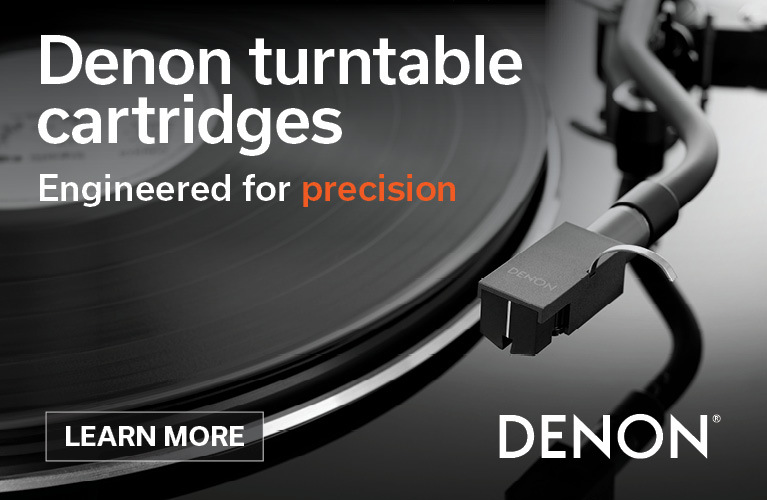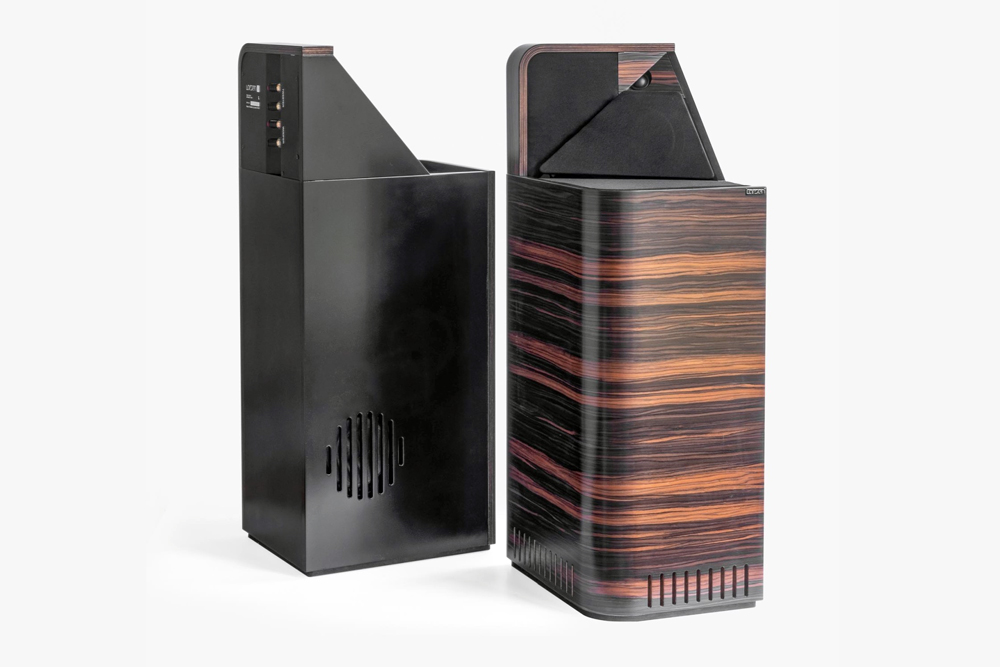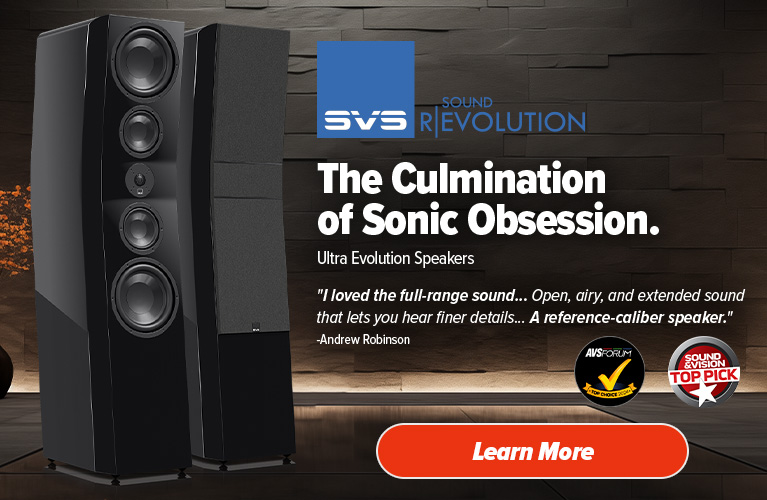Until recently, Larsen was a brand name unfamiliar to me. Upon learning they employ an Ortho-acoustic design, my mind conjured images of a white robed man cradling an unusual speaker design on the pages of a once popular print Hi-Fi magazine (I’m pretty sure that memory is correct even though a decent Google search couldn’t back me up). The original plan was for a review of the Larsen model 8.2 however a last-minute change resulted in a pair of the flagship model 9 being delivered to my door. To quote a diminutive Jedi master, “Disappointed I was not”.
Space Invaders… Not
Inauspiciously packaged for a flagship design, the Larsen 9s were also a pleasant surprise when it came to unboxing and getting them into position – a task I was able to complete relatively easily single-handedly and without having to visit a chiropractor two days later.
Larsen 9 cabinet is solidly built, features curved birch plywood sides and a series of wooden slots for ports, an interesting design but, between you and I, the aesthetics don’t exactly scream out ‘high-end’. However, “I’m just not that superficial”, I mused as I connected them to my amplifier using Nordost White Lightning speaker cables.
Since there was no owner’s manual provided (apparently Larsen are working on one) I jumped onto the website and refreshed myself on the Ortho-acoustic design principles which, in essence, involve overcoming the well-known and long-standing problem of first and second reflections polluting the direct sound emanating from conventional box speakers. This is achieved by arranging the directivity patterns of the drivers in such a way that the reflected sound from room boundaries will have pretty much the same spectral balance as the direct output, allowing the speaker to reproduce the body, openness and airiness of live sounds and allowing the listener to enjoy this throughout a larger area within the listening room (more detail can be found here).
The Larsen 9 is a 2.5-way floor standing loudspeaker utilising top-of-the-line Illuminator drivers from Scan-Speak. No less than three 1-inch tweeters are used; two flanked by absorbers firing upward and high-pass filtered at 5kHz while the main tweeter is surrounded by a stainless-steel plate crossing over to a 7-inch mid-bass driver at 2.5kHz and fires diagonally into the room. Lower frequencies are handled by both the mid bass and a 7.75-inch bass driver low-pass filtered at 300Hz and housed in what Larsen refer to as a ‘triangular bass reflex’ design. This achieves a claimed in-room frequency response from 20kHz all the way down to 22Hz. This is impressive for a speaker of this size. Rated at 200 watts with 4 ohms nominal impedance and 88dB sensitivity (1m on-axis, 2.83V) they represent a fairly typical load and should work well with most high-quality amplifiers.
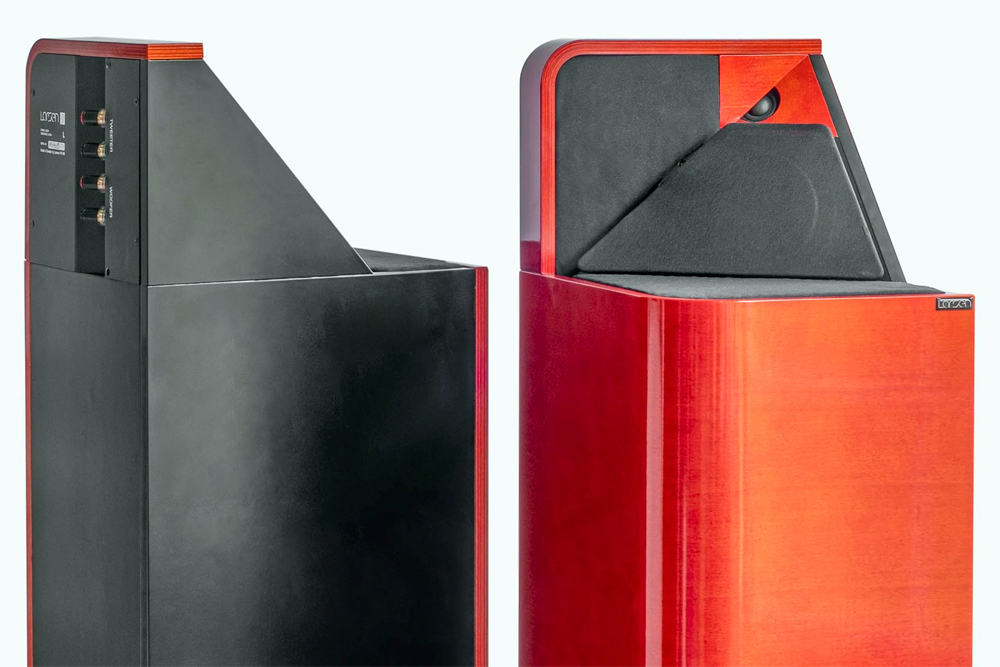
As an amateur speaker designer, I’m always curious about component choices and so I was rapt to learn from John Larsen that they tested a lot of drivers for the model 9, knowing that the quality of the drivers and their ability to perform well in the Ortho-acoustic design was paramount. Having selected premium Scan-Speak drivers, Larsen was able to craft the crossover. Time alignment across the drivers is critical in these designs which meant a lot of research, testing and modelling. Jantzen foil coils and Jensen capacitors were selected after extensive listening tests to achieve a result which, to quote John Larsen “we are very proud of”.
Listening
First impressions on listening to the Larsen 9s were that if the speakers had a personality it would be a very sure of themselves, self-confident one. There is surprising depth and agility, the sound being far bigger than their size would suggest.
On the track “So and So” from Holly Cole’s Don’t Smoke in Bed album, the finger snapping was eerily realistic, as was the resonance from the piano. The finger work on the double bass was fast and powerful. Similarly, on the track “Ev’rything I’ve Got Belongs to You”, what stood out was the lifelike sense of space occupied by the piano. As with the finger snapping the percussion was crisp with lovely attack. I find Cole’s vocals gorgeous. Through the Larsen 9s they seemed even more natural and full-bodied than what I was expecting. I recently saw the Ali Bodycoat Quartet at The Ellington Jazz club. Seeing live music is the perfect way to reconnect yourself with the reality of how instruments sound. The Holly Cole tracks had a similar level of ‘presence’ in my room as I experienced at The Ellington.
Terry Callier’s “Jazz My Rhythm and Blues” and “What You Gonna Do About Me” from his Lookin’ Out album seemed slightly bloated around 80-100Hz. I wondered how I’d missed this on the Holly Cole tracks and whether perhaps the speakers had been voiced with a little extra ‘fatness’ to make them sound a little larger. I decided to experiment a little with the positioning. I had started with the Larsen 9s placed 50cm from the side walls and found that in my room the optimum distance from the side walls (the minimum recommendation) was aesthetically pleasing. After a series of trials moving them around 5cm each time, I found that the ‘fatness’ seemed to disappear at a distance of 67cm from the side wall (still aesthetically manageable). At this distance there was more extension and less bloat.
Reducing the distance between the speakers however will also affect the optimum listening distance from the speakers. Being closer to an equilateral triangle gives a slightly more intimate sound-field and more precise imaging but with a slight trade-off in the level of the lower bass notes. However, the effect was less noticeable with the Larsen 9s than with typical box speakers probably because of the reduced bass nodes. With conventional box speakers the performance potential is constrained by a combination of the amount of space you have and the aesthetics that can be tolerated. With the unusual but well thought out design of the Larsen 9s you can achieve fantastic results much more easily and in a much larger range of rooms.
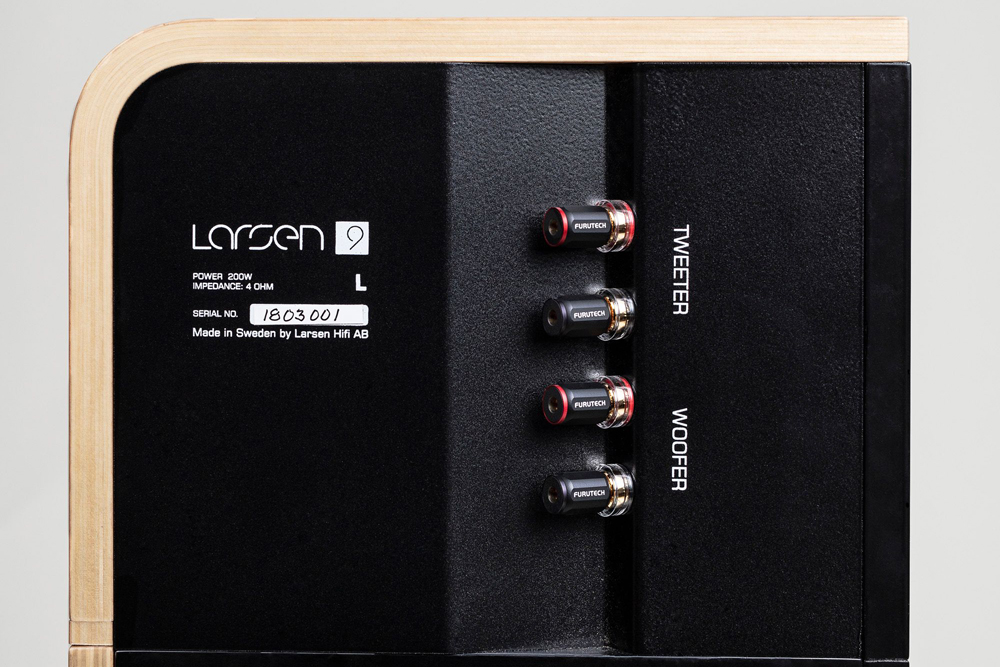
The Larsen 9 uses foam discs inserted into the base of the cabinet as feet. This is an unusual but quite effective approach on my timber floor but, had my room been carpeted, I would have preferred spikes and the ability to level the speakers.
The Hadouk Trio’s “Le Petit Sheval Mopse” from their Now album weaves together a variety of traditional instruments from Zimbabwe, India and the Middle East with, at times, an almost mesmerising effect. This style of acoustic music allowed the Larsen 9s to create a room filling soundstage. The percussion and drums were fabulous with, in some cases, edge of your seat impact. The duduk (an ancient Armenian double reed woodwind instrument made of apricot wood) was super-smooth.
Allan Taylor’s “Beat Hotel” from the album Hotels and Dreamers lacked the resonant bass I’d heard on other systems but when I compared it to what was delivered via my Sennheiser Momentum 2 headphones, it was bang-on in both depth and power demonstrating that what was delivered on those other systems was in fact not true to the source.
Taking a small classical diversion, I tried Edvard Grieg’s Holberg Suite “From Holberg’s Time: Suite in the Olden Style” (Richard Tognetti, Australian Chamber Orchestra). The violins were gorgeous, both sweet, powerful and fast, clearly capturing the emphasis placed by the musician. Similarly, on Olli Mustonen’s Sonata for Cello and Chamber Orchestra, track 2 “Andantino”, the strings were almost palpable.
Earl Wild’s Rachmaninoff Piano Concerto Number 2 Isle of the Dead was exquisite. The strings and the way the dynamics of the piano were portrayed were stunning. The sense of space within the soundstage reaching far beyond the front wall.
Having discovered Van Morrison’s 2018 The Prophet Speaks this morning while waiting for my drive-through coffee I’d been eager to see what the Larsen 9s would make of it. It’s hard not to like Morrison’s large arrangements and blues compositions. Easier still when the vocals, guitar and saxophones own their space as was evident on the track “Got to Go Where the Love Is” where the sense of ambience at the end of the track was quite lifelike. And on “Laughing and Clowning”, the sax solo steals the show, with the drums having the requisite snap and power and the cymbals shimmering.
Welcome to The Future
When it comes to ‘Best Of’ albums, one of the best I’ve ever heard is from guitarist Thomas Blug. At two hours and forty minutes and every track a winner, it’s a mighty decent effort. Through the Larsen 9s the bass is rock solid on “I Won’t Forget”. The guitar is almost ethereal and cymbals shimmer as they do when reproduced correctly. At around four minutes and twenty seconds in, Blug really cuts lose – you just want to keep turning it up... My SPL meter remained fairly steady at approximately 93dB (4m distance) for the rest of the track. For me, this track could be one of the best six minutes and 56 seconds I’ve ever spent vertical. Similarly, on the chaser “Aqua Di Mare” and again in the absolutely lovely live track “No Way to Istanbul” the Larsen 9s captured the atmosphere and revealed the ambience of the venue. On “Welcome to the Future” the sound slowly builds until the band hits full stride. I’m now averaging over 100dB with peaks up to 104.5dB! The kick drum and the expansiveness of the stage is quite amazing. Here the Larsen 9s operate somewhat like a Star Trek transporter in that when I closed my eyes it was like being transported directly to the venue.
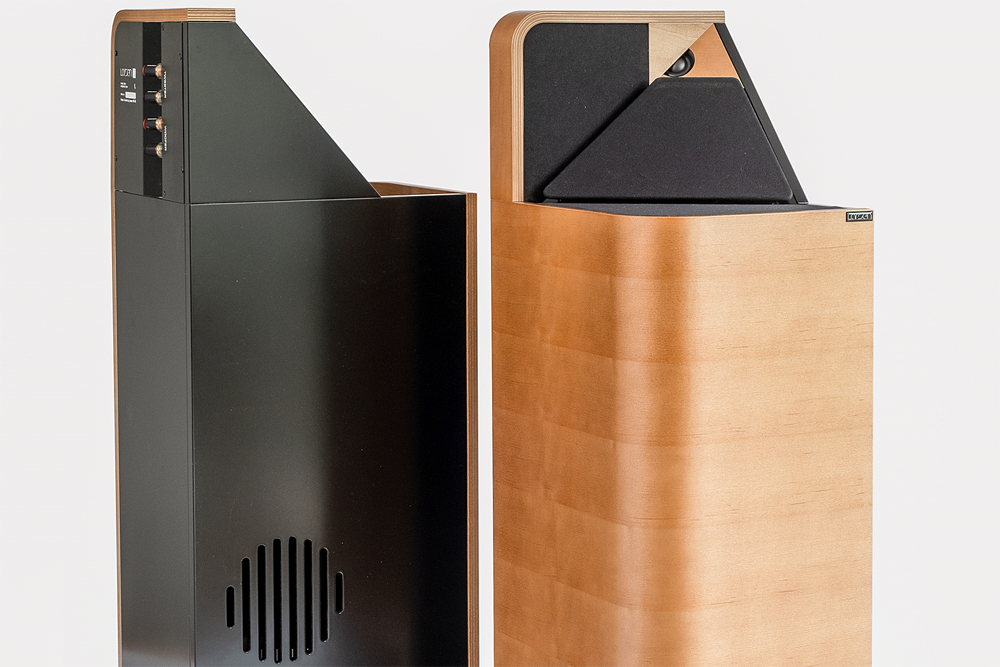
Roon radio took me from Blug (yes, I did make it all the way two hours and forty minutes!) to Friday Night in San Francisco by guitarists Al Di Meola, John McLaughlin and Paco de Lucia. Many of the tracks are live recordings and most of them highly enjoyable on performance value alone. Here as well, the Larsen 9s continued to deliver the goods. For example, the attack on heavily-struck chords and where the body of the guitar was struck was almost startling.
Compared to the best I’ve ever heard it replayed; the overall attack was perhaps ever so slightly subdued on Oscar Peterson’s “You Look Good to Me” from his We Get Requests album. However, the soundstage was wide and deep and spatially correct. The double bass seemed to occupy real space (a consistent observation throughout my time with the Larsen 9s). Peterson’s piano was as full bodied here as I’ve heard it and the brushes on the drums were very realistic.
Overall Impressions
Surprisingly deep, powerful and agile bass. I played a bunch of albums and this one thing, which is often elusive in many systems, was consistent across a range of different musical genres and recordings. In my experience, minimising room interactions is a most admirable pursuit and tends to normalise the bass avoiding the peaks and troughs that occur on in-room frequency response curves. The result may take a little getting used to as the peaks and troughs can make some recordings sound good (and others sound lacklustre), but when the peaks and troughs are minimised you hear what it actually should sound like.
Detailed imaging. While not the most detailed I’ve ever heard, it was satisfyingly revealing, and achievable from a larger sweet spot than you’ll get from more traditional designs, which is great when there is more than just you enjoying the music. I was never left wanting more and only aware there might be more when doing an A/B comparison to my Sonus faber Amati. I suspected this might be down to the complexity of the crossover required in the Ortho-acoustic design.
Deep soundstage. It was sometimes counter intuitive when opening your eyes after listening with your eyes closed. The effect was particularly noticeable on classical music where the back of orchestra was clearly behind the font wall of the listening room.
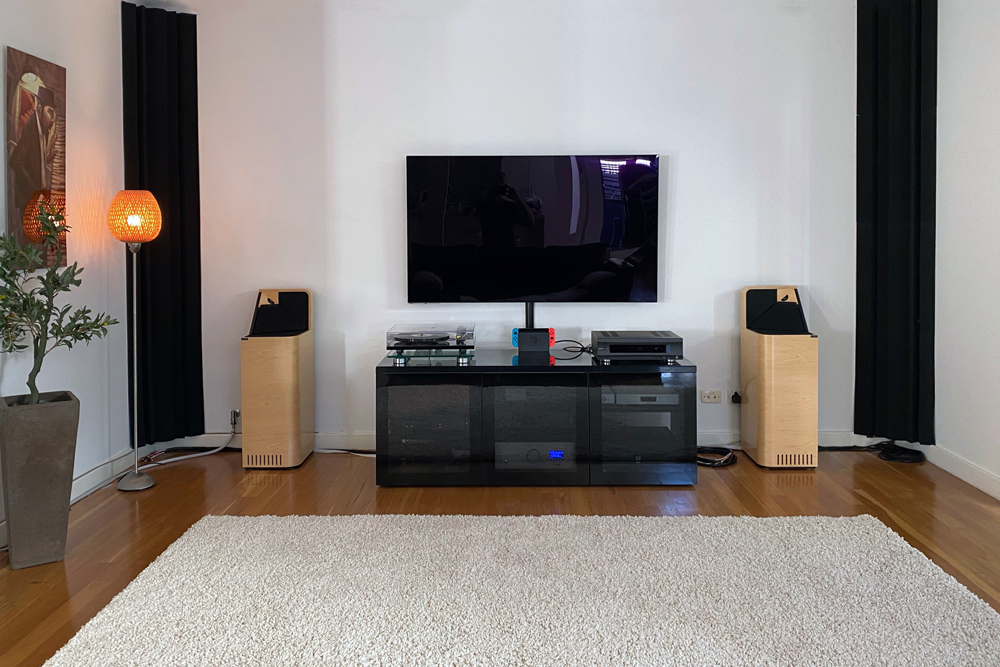
At the upper end of the frequency range, I felt the Larsen 9s were slightly rolled off and this was confirmed in an A/B comparison. The sound was for the most part eminently satisfying but there were a handful of occasions where I felt they lacked a little ‘airiness’ compared to other high-end designs. Having said this, the quality of the upper registers was pristine. There was never any edginess even at very high-volume levels.
If I had to choose one word to describe the Larsen 9s, it would be “Beguiling”, this word having sprung to mind frequently throughout my listening sessions.
Conclusion
The Larsen 9 should be a serious contender for any enthusiast looking for the real thing. I just can’t imagine anyone not being impressed with these speakers. I liked them so much I wrestled with the idea of buying them continuously throughout the five-week review period. If I wasn’t already accommodating two pairs of serious speakers in my house and had room for a third… I would have!
They’re most likely not for the audiophile who has no constraints but rather for those who want a speaker that can perform properly in real world listening environments. In particular within rooms where they can be placed on the longest wall and more than 60 cm from side walls. I glimpsed Nirvana with a distance of 75 cm from the side walls spaced 2.3m apart and a listening distance of 4m from the front wall.
Perhaps the Larsen 9’s most significant strength is ‘consistency’. I played a diverse range of music throughout the review at a range of volume levels and was never disappointed. They are, in my opinion, extraordinarily well-rounded and well-balanced loudspeakers.
… Barry Jones
Associated Equipment:
- Speakers — Sonus faber Amati Homage
- Amplifier — Perreaux e250i 40th Anniversary Edition integrated amplifier
- Sources — Digital: Lumin T1, Oppo BDP-105D Analogue: Rega RP6 turntable, Rega Exact-2 cartridge, Rega Aria phono stage, Rega Couple interconnects
- Processor — DEQX HDP-5
- DAC/Headphone Amplifier — Chord Mojo DAC
- Headphones — AudioQuest Nighthawk
- Cables — Nordost White Lightning, Kimber Cable Timbre balanced and van den Hul D-300III unbalanced interconnects, Atlas Compass Digital Coaxial Audio Cable, QED Performance Graphite USB
- Miscellaneous— Isotek Sirius Power Conditioner, 8 x Auralex SA8600 bass traps in front wall corners, 12 x Sound Acoustics MP700-40 ceiling acoustic panels
Larsen 9 Loudspeakers
Price: AU$22,000
Warranty: 12 Months
Australian Distributor: Nirvana Sound
1300 988 366
www.nirvanasound.com
Larsen Hi-Fi
Bokgatan11
SE-568 31 Skillingaryd
Sweden
+46 370 70900
www.larsenhifi.com

